Lerwick, Shetland Islands, Scotland, UK 作者: 来源: 发布时间:2021-09-17
I. Population and Area
Continent: Europe
Country: The U.K
State/Province: Scotland
City/Town: Paisley, Renfrewshire
Total Area: 1.22 (sq mi)
Population in 2011: 6.96 (thousand)
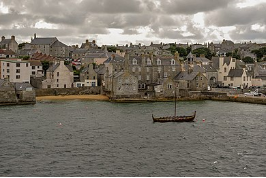
II. Natural Geography (environment and resources)
Climate
Lerwick has an oceanic climate (Cfb) closely bordering on a subpolar oceanic climate (Cfc) with cool to cold temperatures all year long. The lack of trees reflects the latter type. Lerwick is also a very cloudy town, averaging only 1,110 sunshine hours annually. February is the coldest month, with high temperatures averaging around 5.5 °C (41.9 °F). In August, the warmest month, average high temperatures are near 14.5 °C (58.1 °F). This produces an extremely narrow difference for an area north of the 60 parallel. In terms of average monthly precipitation, October to January are the year's wettest months, with over 5.5 inches of precipitation each month; May and June are the driest months, with average monthly precipitation less than 2.3 inches each. Snowfall can occur, primarily from December to March, but snow accumulation is rarely heavy and usually short-lived. The exposed North Atlantic location and proximity to autumn and winter storm tracks means high winds are a regular occurrence, alongside high levels of cloudiness and precipitation. The weather station is at an elevation of 82 metres (269 ft) so temperatures are likely to be slightly milder in the town centre at sea level.
Owing to its northerly location, winter months are extremely dark in Lerwick. On the day of the winter solstice it gets only 5 hours and 49 minutes of daylight In sharp contrast daylight lasts 18 hours and 55 minutes on the day of the summer solstice. As a result, nights never get completely dark for a period of time in summer, with dark blue elements remaining in the sky. The maritime influence tempers the climate effects of these swings in daylight, but in many areas of the world this latitude has hostile winters. Farther north in the world, only the Faroe Islands have such high January averages as Lerwick and fellow Shetland station at Baltasound – with the warm Atlantic currents preventing ice formation. Only when temperatures in continental areas are record cold does Lerwick experience some cold as was the case in December 2010 during the severe cold wave affecting the British Isles and Europe that covered much of England in snow. Even so, average highs remained above 3 °C (37 °F) and frosts were light. Even warm summers are also extremely rare with the warmest recorded month being July 2006 at an average high of 16 °C (61 °F).
Transportation
Lerwick is served by the Tingwall Airport located a few miles away and Sumburgh Airport that is further south and flies all year to some Scotland destinations. NorthLink Ferries operate a daily overnight ferry service between Lerwick and Aberdeen, regularly calling in to Kirkwall in the Orkney Islands. The Shetland Islands Council operate a ro-ro ferry service to Out Skerries and Bressay from a terminal in the centre of the town. The local bus service is provided by the Regional Transport Partnership (ZetTrans) and operated by a number of different local bus service operators.
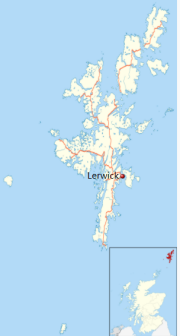
III. Economy
Orkney is a vibrant, energetic and forward-looking community, punching well above its weight in the world.
The islands are a relatively prosperous part of Scotland and do well on many economic measures, with low unemployment and high levels of household income. We also have rich natural resources and are set to play a vital part in the country’s move towards a greener economy.
But there are challenges too, many reflecting our unique location and issues surrounding transport connections and population changes.
Agriculture, fisheries and aquaculture
The Orkney economy has had a traditional reliance on agriculture and fishing. Even a short drive through the local countryside highlights our farming heritage, with sheep and cattle in green fields across the islands. Our high quality, fertile farmland means that Orkney beef and lamb is much sought after, and the standard of our grassland helps support a large number of dairy herds. North Ronaldsay is also home to a unique breed of seaweed-eating sheep, with the mutton considered a delicacy in restaurants around the world.
The aquaculture industry has really grown over recent years, with new fish farm facilities installed around Orkney, taking advantage of our clean waters and strong tides. Around 20,000 tonnes of farmed salmon are produced in Orkney every year, and the industry continues to create job opportunities, especially in some of our smaller islands.
Another mainstay of the Orkney economy over recent decades has been the oil and gas industry. Oil arrived in the islands in the late 1970s when the newly-commissioned Flotta Oil Terminal began receiving ‘black gold’ from fields in the North Sea. At its peak the terminal processed more than 400,000 barrels annually and brought jobs and prosperity to many islanders. Nowadays the throughput is much smaller but the terminal continues to process oil and tanker traffic. Scapa Flow is a hub for ship-to-ship transfers of oil too.
There are plans in place to mitigate any loss of oil revenue in the future, with proposals for deep water berths - ideal for decommissioning work and support vessel services - being considered.
Orkney is also one of the most popular cruise ship destinations in the country, bringing more than a hundred ships to the islands annually – and around £2m worth of income to Orkney Islands Council in harbour revenue.
Reference Website:
https://www.orkney.com/life/live/economy
IV. Industrial Characterisitics
Major industries:
Lerwick is a busy fishing and ferry port. The harbour also services vessels supporting the offshore oil industry.
Today, the main revenue producers in Shetland are agriculture, aquaculture, fishing, renewable energy, the petroleum industry (crude oil and natural gas production), the creative industries and tourism. Possibly in the future there could be a rocket launch pad called the Shetland Space Centre.
Fishing
Fishing remains central to the islands' economy today, with the total catch being 75,767 t (83,519 tons) in 2009, valued at over £73.2 million. Mackerel makes up more than half of the catch in Shetland by weight and value, and there are significant landings of haddock, cod, herring, whiting, monkfish and shellfish.
Energy and fossil fuels
Oil and gas were first landed in 1978 at Sullom Voe, which has subsequently become one of the largest terminals in Europe. Taxes from the oil have increased public sector spending on social welfare, art, sport, environmental measures and financial development. Three quarters of the islands' workforce is employed in the service sector, and the Shetland Islands Council alone accounted for 27.9% of output in 2003. Shetland's access to oil revenues has funded the Shetland Charitable Trust, which in turn funds a wide variety of local programmes. The balance of the fund in 2011 was £217 million, i.e., about £9,500 per head.
In January 2007, the Shetland Islands Council signed a partnership agreement with Scottish and Southern Energy for the Viking Wind Farm, a 200-turbine wind farm and subsea cable. This renewable energy project would produce about 600 megawatts and contribute about £20 million to the Shetland economy per year. The plan met with significant opposition within the islands, primarily resulting from the anticipated visual impact of the development. The PURE project in Unst is a research centre which uses a combination of wind power and fuel cells to create a wind hydrogen system. The project is run by the Unst Partnership, the local community's development trust.
Major projects and related introductions:
A design to stimulate the local area
NHS Orkney issued a very specific, bespoke brief that required a rural general hospital with particular attention to be paid to the unique needs of Orcadians. Working with Keppie, the hospital was designed to put people first and make a positive contribution to the environment, local community and economy. It is predicated on 'place-making' to give the whole building a depth and level of design missing in many hospitals. This rural general hospital has a large number of small departments and areas, several of which need distinct identities. An interrelated series of ‘streets’ and spaces are situated along patterns of established movement, arranged around a single central hub. From this public space, wayfinding is easy and intuitive, and the space is visually connected with external courtyards to further remove the traditional institutional associations. The different spaces and activities come together effectively, delivering efficient clinical adjacencies that were required. The design is a strong, contemporary building that is rooted in the culture and context of Orkney in general, but Kirkwall in particular. Robertson Specialist Division carried out all external render, providing a brilliant white water- and dirt-resistant finish that is suited to the location
Reference Website:
https://www.robertson.co.uk/project/balfour-orkney
V. Attractions
1. Shetland Museum :
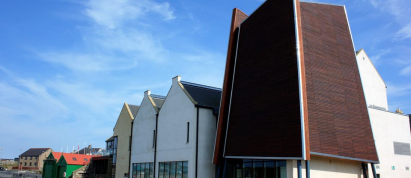
This museum houses an impressive collection of 5000 years’ worth of culture, people and their interaction with this ancient landscape. Comprehensive but never dull, it covers everything from the archipelago’s geology to its fishing industry, via local mythology – find out about scary nyuggles (ghostly horses), or detect trows (fairies). Pictish carvings and replica jewellery are among the finest pieces. The museum also includes a working lighthouse mechanism, a small gallery, a boat-building workshop and an archive for tracing Shetland ancestry.
2. Up Helly Aa:
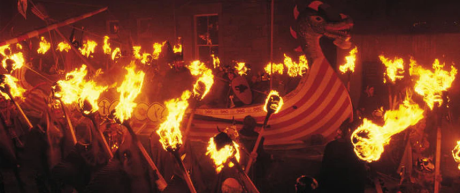
Shetland's long Viking history has rubbed off in more ways than just street names and square-shouldered locals. Most villages have a fire festival, a continuation of Viking midwinter celebrations of the rebirth of the sun, with the most spectacular happening in Lerwick, on the last Tuesday in January.
Squads of guizers dress in Viking costume and march through the streets with blazing torches, dragging a replica longship, which they then surround and burn, bellowing out Viking songs from behind bushy beards.
3. Hay’s Dock:
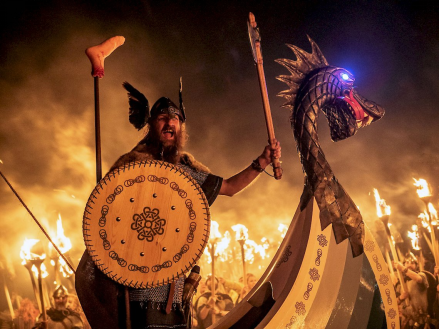
Upstairs in the Shetland Museum, this place sports a wall of picture windows and a fair-weather balcony that overlooks the harbour. Clean lines and pale wood recall Scandinavia, but the menu relies on carefully selected local and Scottish produce, with a substantial dash of international influence. Lunch ranges from delicious fish and chips to chowder, while evening menus concentrate on seafood and steak.
Reference Website:
https://www.inspirock.com/united-kingdom/things-to-do-in-lerwick
VI. History
Lerwick is a name with roots in Old Norse and its local descendant, Norn, which was spoken in Shetland until the mid-19th century. The name "Lerwick" means bay of clay. The corresponding Norwegian name is Leirvik, leir meaning clay and vik meaning "bay" or "inlet". Towns with similar names exist in southwestern Norway (Leirvik, Lervik) and on the Faroe Islands (Leirvík).
Evidence of human settlement in the Lerwick area dates back to the Neolithic (4000–2500 BC) and the Bronze Age (2500–800 BC) known from paleoenvironmental records for human activity and the recovery of artefacts, including a stone axe head submerged in Bressay Sound. Iron Age (800 BC – AD 800) settlement is known at the Broch of Clickimin, which was constructed as early as 400 BC. The first settlement to be known as Lerwick was founded in the 17th century as a herring and white fish seaport to trade with the Dutch fishing fleet. This settlement was on the mainland (west) side of Bressay Sound, a natural harbour with south and north entrances between the Shetland mainland and the island of Bressay. Its collection of wooden huts was burned to the ground twice: once in the 17th century by the residents of Scalloway on the western side of Mainland, then the capital of Shetland, who disapproved of the immoral and drunken activities of the assembled fishermen and sailors; again in 1702 by the French fleet.
Fort Charlotte was built in the mid 17th century on Lerwick's waterfront, and permanent stone-built buildings began to be erected around the fort and along the shoreline. The principal concentration of buildings was in the "lanes" area: a steep hillside stretching from the shoreline to Hillhead at the top. Lerwick became capital of the Shetland Islands in 1708, taking over the function from Scalloway. The civil parish of Lerwick had been in 1701 created from a small part of the parish of Tingwall, to which Scalloway still belongs. When Lerwick became more prosperous through sea trade and the fishing industry during the 19th century, the town expanded in 1891 to the west of Hillhead, thereby including the former civil parishes of Gulberwick and Quarff, as well as the islands parish of Burra. Lerwick Town Hall was built during this period of expansion.
Lerwick war memorial dates from 1923 and was designed by Sir Robert Lorimer. The next period of significant expansion was during the North Sea oil boom of the 1970s when large housing developments were built to the north of Staney Hill (located in Lerwick) and to the south (Nederdale and Sandveien).
VII. Culture
Lerwick has strong ties with Scandinavian countries, particularly Norway (Lerwick has a friendship agreement with Måløy in Norway), and this is reflected in the street names of Lerwick (e.g., King Harald Street, King Haakon Street).
The Reformation reached the archipelago in 1560. This was an apparently peaceful transition and there is little evidence of religious intolerance in Shetland's recorded history.
In the 2011 census, Shetland registered a higher proportion of people with no religion than the Scottish average. Nevertheless, a variety of religious denominations are represented in the islands.
The Methodist Church has a relatively high membership in Shetland, which is a District of the Methodist Church (with the rest of Scotland comprising a separate District).
The Church of Scotland has a Presbytery of Shetland that includes St. Columba's Church in Lerwick. The Catholic population is served by the church of St. Margaret and the Sacred Heart in Lerwick. The Parish is part of the Diocese of Aberdeen. The Scottish Episcopal Church (part of the Anglican Communion) has regular worship at St Magnus' Church, Lerwick; St Colman's Church, Burravoe; and the Chapel of Christ the Encompasser, Fetlar; the last of which is maintained by the Society of Our Lady of the Isles, the most northerly and remote Anglican religious order of nuns.
The Church of Jesus Christ of Latter-day Saints has a congregation in Lerwick. The former print works and offices of the local newspaper, The Shetland Times, has been converted into a chapel.
VIII. Other information
After the islands were officially transferred from Norway to Scotland in 1472, several Scots families from the Scottish Lowlands emigrated to Shetland in the 16th and 17th centuries. Studies of the genetic makeup of the islands' population, however, indicate that Shetlanders are just under half Scandinavian in origin, and sizeable amounts of Scandinavian ancestry, both patrilineal and matrilineal, have been reported in Orkney (55%) and Shetland (68%). This combination is reflected in many aspects of local life. For example, almost every place name in use can be traced back to the Vikings. The Lerwick Up Helly Aa is one of several fire festivals held in Shetland annually in the middle of winter, starting on the last Tuesday of January. The festival is just over 100 years old in its present, highly organised form. Originally held to break up the long nights of winter and mark the end of Yule, the festival has become one celebrating the isles' heritage and includes a procession of men dressed as Vikings and the burning of a replica longship. Shetland also competes in the biennial International Island Games, which it hosted in 2005.
The cuisine of Shetland is based on locally produced lamb, beef and seafood, much of it organic. Inevitably, the real ale-producing Valhalla Brewery is the most northerly in Britain. The Shetland Black is a variety of blue potato with a dark skin and indigo-coloured flesh markings.
IX. Contact information
Mayor/Officer: Alastair Cooper
Tel: 07990 540708
Mail: alastair.cooper@shetland.gov.uk
Reference Website:
https://www.shetland.gov.uk/councillors/3/alastair-cooper
